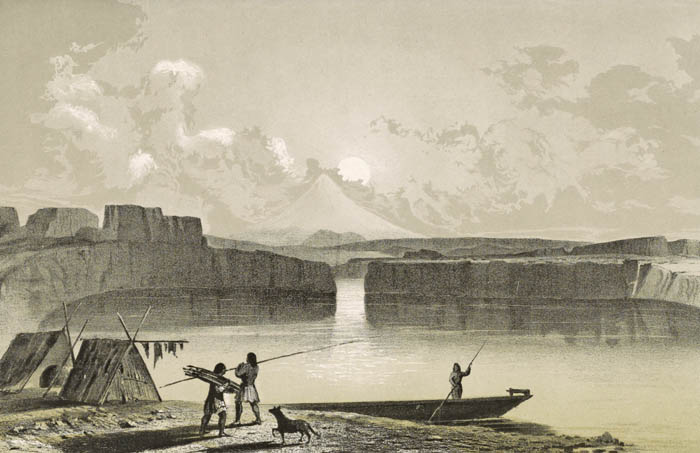
Echoes in the Hollow: Unearthing the Phantom Battle of Washington’s Sand Hollows
America is a tapestry woven with stories – grand narratives of nation-building, individual triumphs, and the relentless march of progress. But beneath these well-trodden paths lie countless other threads, fainter and more elusive: the legends. These are the whispers in the wind, the shadows in the periphery, the tales that defy easy explanation yet resonate deeply within local lore. From the spectral riders of the headless horseman to the cryptids lurking in vast wildernesses, American legends offer a window into our collective psyche, our fears, and our enduring fascination with the unknown.
Among these enigmatic narratives, one particular tale from the Pacific Northwest stands out, not for its historical documentation, but for its persistent, unsettling presence in the oral tradition of a specific, secluded locale: the alleged "Battle of Sand Hollows" in Washington State. While historians might search their archives in vain for official records, the echoes of a forgotten skirmish, a desperate struggle veiled in mist and mystery, continue to resonate for those who live near the rugged, often overlooked stretch of terrain known simply as Sand Hollows.
The Landscape of Legend: Sand Hollows, Washington

To understand the legend, one must first understand its setting. Sand Hollows, a name suggestive of geological peculiarity and perhaps a degree of isolation, describes a series of depressions and ravines, often characterized by sandy soil and dense, second-growth forest, nestled somewhere in the less-traveled expanses of Washington State. Its precise location is often spoken of in hushed tones, almost as if pinpointing it too exactly might disturb the restless spirits said to linger there. It is a landscape that naturally lends itself to mystery: overgrown, shadowed, and prone to the kind of atmospheric phenomena – sudden fogs, disorienting echoes, the rustle of unseen creatures – that can easily blur the line between reality and imagination.
For generations, particularly among the older residents of nearby, small logging towns or remote farming communities, Sand Hollows has carried a peculiar reputation. It’s a place people avoid after dark, a place where compasses are rumored to spin wildly, and where, some claim, an unearthly chill can settle even on the warmest summer day. It is within this atmospheric crucible that the legend of the Battle of Sand Hollows has taken root and flourished.
The Whispers of Conflict: A Battle Without Records
The core of the legend speaks of a fierce, bloody confrontation that occurred in the Sand Hollows sometime in the mid-19th century, during the tumultuous period of westward expansion and early settlement. The specific details, like much oral history, vary with each telling, yet a consistent narrative thread emerges: two desperate, clashing parties, a fight for land or resources, and a tragic, unresolved outcome.
One common version posits a brutal skirmish between a small, ill-equipped band of early prospectors or settlers – perhaps searching for gold or attempting to stake claims in what was then wild, untamed territory – and an equally determined, territorial group of indigenous inhabitants. This was a period rife with such conflicts, often undocumented or deliberately suppressed in official histories, as the push for land and resources frequently led to violent clashes between newcomers and the Native American tribes who had stewarded these lands for millennia.
Another variant suggests a more internal conflict: a clash between rival groups of settlers, perhaps over a rich mineral find, or a dispute that escalated tragically in the isolation of the hollows. The Pacific Northwest, with its challenging terrain and often lawless frontiers, saw its share of private wars and bloody feuds that never reached the attention of distant authorities.
What unites these differing accounts is the consensus that the battle was quick, brutal, and left no clear victor. Instead, the story goes, both sides suffered heavy losses, and the survivors, if any, either vanished into the wilderness or were so traumatized that they never spoke of the incident again, leaving only the land itself to bear witness.
"Old Man Hemlock, who lived up on Miller’s Ridge, used to say the ground out there drinks deep," recalls Agnes Peterson, a spry 87-year-old whose family has lived in the region for five generations. "He swore you could still smell the gunpowder on a windy night, like the air itself remembered the fight. He said it wasn’t a battle for history books, but for the trees and the rocks."

The Unseen Evidence: Signs and Portents
If no official records exist, what keeps the legend alive? It is, as with many such American tales, the collection of inexplicable phenomena and anecdotal "evidence" that locals have attributed to the Sand Hollows.
- Eerie Silence and Disorientation: Visitors to certain parts of the Hollows often report an unnerving silence, a profound lack of bird song or animal noise, even in otherwise vibrant forest. Coupled with this are frequent claims of feeling disoriented, losing one’s sense of direction, or experiencing sudden, inexplicable drops in temperature.
- Phantom Sounds: The most compelling "evidence" for many are the alleged auditory phenomena. Whispers on the wind, distant shouts, the clang of metal, or even faint, mournful cries are said to emanate from the hollows, particularly around dusk or in the dead of night. Skeptics attribute these to natural wind effects, animal sounds, or the power of suggestion, but for believers, they are the lingering echoes of the battle.
- Unusual Occurrences: There are tales of strange lights flickering among the trees, unexplained shadows moving through the undergrowth, and even occasional reports of objects being moved or dislodged by an unseen force. Some locals speak of compasses spinning wildly or electronic devices malfunctioning when brought into the deepest parts of the Hollows.
- The Unmarked Graves: While no official burial ground has ever been found, the legend often includes the belief that the fallen were buried hastily and without ceremony, their graves unmarked and forgotten by all but the land itself. Some claim to have seen depressions in the ground that resemble old graves, or to have stumbled upon fragments of rusted metal – perhaps a buckle, a tool, or even a piece of an old firearm – that hint at past human activity.
Dr. Eleanor Vance, a folklorist at the University of Washington who specializes in regional American legends, offers a perspective on the persistence of such stories. "Legends like the one at Sand Hollows serve as a cultural mirror, reflecting our anxieties, our hopes, and our attempts to grapple with the unknown," she explains. "In places like the Pacific Northwest, with its vast, untamed wilderness and complex history of early settlement and indigenous displacement, stories of lost battles or forgotten tragedies are incredibly potent. They fill the gaps in our historical record, providing a narrative framework for unexplained phenomena or simply giving voice to the sense that profound events once transpired in a particular place, leaving an indelible mark."
The Fabric of American Legend: Filling the Voids
The legend of the Battle of Sand Hollows, while specific to its location, is part of a broader tapestry of American legends that seek to explain the unexplained, to give form to the formless, and to remember what official history has forgotten. From the ghosts of Civil War battlefields that still march across Gettysburg to the spectral figures said to haunt the forgotten mining towns of the Old West, America is rich with tales of lingering conflict.
These legends often arise in places of transition or friction: where wilderness meets civilization, where cultures clash, or where sudden, violent events occurred without proper witness or documentation. The hollows, ravines, and remote forests of America are perfect incubators for such stories, as they naturally evoke a sense of isolation, mystery, and a separation from the ordered world.
What the Sand Hollows legend highlights is the human need for narrative, even in the face of an absence of concrete facts. It speaks to a deep-seated desire to believe that significant events, particularly those involving sacrifice or injustice, do not simply vanish without a trace. The land itself, in these narratives, becomes a sentient keeper of memory, echoing the past through subtle signs and atmospheric shifts.
"Every landscape has its secrets," notes Vance. "And when those secrets involve human struggle and loss, they often manifest as legends. It’s how communities process their history, even the parts that are uncomfortable or too vague to be officially recorded. The ‘Battle of Sand Hollows’ might not appear in any textbook, but for those who believe, it’s a very real part of their local heritage, a warning, a lament, and a connection to a past that refuses to be completely silent."
The Enduring Power of the Unseen
In an age of satellite imagery, ubiquitous documentation, and instant information, the idea of a "lost battle" in a place as accessible as Washington State might seem anachronistic. Yet, the persistence of the Sand Hollows legend reminds us that there are still vast tracts of American wilderness, and indeed, vast realms of human experience, that resist easy cataloging. The forests of the Pacific Northwest, with their dense canopies and often treacherous terrain, still hold secrets, still obscure untold stories.
The Battle of Sand Hollows, whether a literal historical event obscured by time and circumstance, or a purely folkloric creation born of the landscape’s inherent mystery and the human imagination, serves as a powerful reminder of the enduring power of legend. It speaks to the countless struggles that shaped early America, many of which occurred far from the gaze of historians. It reminds us that history is not just what is written, but also what is remembered, whispered, and felt.
For those who venture into the deep, shadowed depressions of Washington’s Sand Hollows, the wind may indeed carry more than just the rustle of leaves. It might carry the faint, ghostly echoes of a long-forgotten battle, a testament to the fact that some stories, even without definitive proof, are simply too compelling, too poignant, and too deeply ingrained in the land to ever truly die. They remain, woven into the very fabric of America’s legendary landscape, waiting for those with an open ear and a curious heart to listen.


